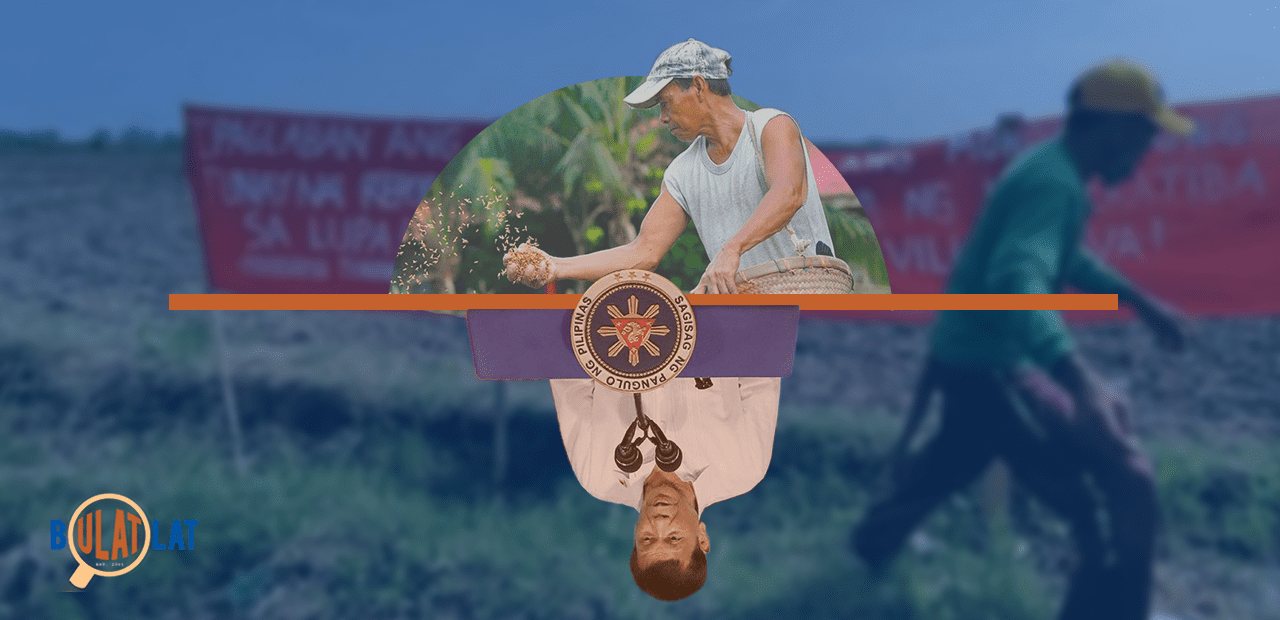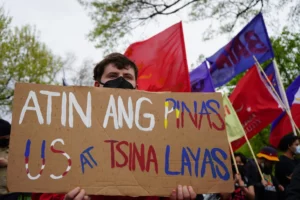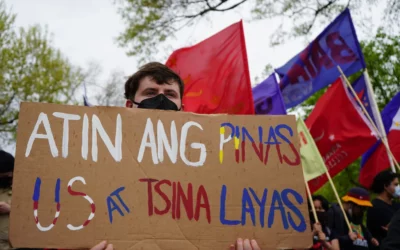Ibon Foundation said that the Rice Tariffication Law has never benefited farmers. From P385 billion in 2018 ($7 billion), the value of palay production declined to P333 billion ($6.06 billion) in 2021 despite an increase of 894,076 metric ton in production volume.
By LIZST ABELLO and ANNE MARXZE D UMIL
Bulatlat.com
MANILA – P12 (USD 0.22) per kilo.
For the first time in his life as a rice farmer, Marlon Padilla, 47, was forced to sell palay (unmilled rice) for P12 per kilo.
This after the Rice Tariffication Law or RA 11023 was enacted, removing the quantitative restrictions on imported rice and imposing tariffs on rice imports. This was supposedly the government’s response to the rice crisis in 2018.
Several farmers’ groups opposed the passage of the bill but despite strong opposition, President Duterte signed it into law in 2019.
Read: Farmers slam Duterte for ‘sealing death of PH rice industry’ with tariffication law
Independent think tank Ibon Foundation pointed out that farmers and farm workers nationwide will not be able to compete with cheaper subsidized imported rice and will see their already low income fall even more.
True enough, Padilla said that from P19 pesos per kilo of palay, they now have to sell at a much lower price.
“We have no choice. It may rot if we wait for the price to rise, which will never happen,” Padilla told Bulatlat in an interview.
Read: Tariffication to worsen dependence on imported rice
Read: Price of palay, cheaper than pig feed
Padilla owns a 10-hectare land, part of which he inherited from his father. He said that he already knew the impact of the law on the industry even before Duterte signed it into law.
“We may be fortunate, because somehow, we were able to invest on machinery and equipment for farming before this happened, helping us in lessening our expenses,” Padilla said.
However, he said that for others who have no capital, “farming is surely inconvenient to the point that they might sell their land or put it in mortgage.”
Ibon Foundation said that the Rice Tariffication Law has never benefited farmers. From P385 billion in 2018 ($7 billion), the value of palay production declined to P333 billion ($6.06 billion) in 2021 despite an increase of 894,076 metric ton in production volume.
They also added that in 2020, rice farmers’ profitability ratio was lower.

Maximo Fulgencio also work as a construction worker to have an extra income. (Photo by Lizst Abello/Bulatlat)
Making ends meet
With the impact of RA 11203 and the soaring prices of fertilizer as well as fuel, farmers and even small land owners have to look for a way to make ends meet.
Maximo Fulgencio, 52, from Nueva Ecija, is not only a rice farmer but also a construction worker.
He has been a rice farmer for almost 30 years. Fulgencio said that he needed to find an extra job since being a rice farmer is not enough to provide for his wife and five children.
Fulgencio said he can only earn 12 cavans of palay in one harvest and sell it for P900 ($16) per cavan or P10,800 ($196) for three months. If there is a good harvest, Fulgencio can gather 30 cavans of palay for six months.
“With my income as a rice farmer, I would not be able to bring my children to school, that is why, I need to have multiple jobs,” he said.
Fulgencio’s son Mark Jander, 20, a scholar taking up Bachelor of Science in Agriculture in Central Luzon State University, meanwhile, hoped that the government would repeal the Rice Tarrification Law.
He lamented that the government should transact directly with local farmers. “With less intervention from private investors, the government might be able to focus on the real needs of the local farmers,” he said.
“In these times, it’s total hardship. Ask how much one cavan of palay is, then compare it to how much a kilo of rice is sold in the market. The farmers are the ones working hard, but the question is if they get the benefits they deserve,” he said.
Olivia Brazil, 52, from Nueva Ecija, has been working in the field for 12 years. She inherited a 1.5-hectare land from her parents. She and her children were the ones directly working in the field before they were able to hire farmers two years ago.
“As for now, we usually have an income of P10,000 ($182) in three months, and that will only be alloted for food,” she told Bulatlat.

Olivia Brazil have to put up a sari-sari store for an extra income. (Photo by Lizst Abello/Bulatlat)
According to Brazil, the high cost of production including fertilizer and diesel leaves them a little amount of income.
Of her five children, two of have yet to finish their studies; this is why it is crucial for them to make both ends meet.
According to Kilusang Magbubukid ng Pilipinas (KMP), fertilizer prices have increased by more than 300 percent since the pandemic — from P800 (USD 15) per 50 kilogram bag in 2020 to a staggering P3,000 (USD 54) per 50 kilogram bag in May this year.
“In our case, we have slight advantages, as my husband is a taho vendor, and I also have a small sari-sari (variety) store. We cannot really survive without these additional sources of livelihood,” she said.
P20 per kilo of rice?
Incoming president Ferdinand Marcos Jr. promised in his campaign that he will lower the price of rice to P20.
The National Economic and Development Authority claimed it was possible without repealing RA 11203. Socioeconomic Planning Secretary Karl Kendrick T. Chua even said that the law is the best model to help both farmers and consumers.
But the farmers groups are not convinced.
Anakpawis National President Ariel Casilao said that Chua claimed during the hearings at the House of Representatives that the price of rice will lower to P25 per kilo once RA 11203 passed, but it did not even happen.
Instead, rice farmers across the country continue to complain of depressed farm gate prices and blame it on the influx of imported rice.
For Fulgencio, the P20 per kilo of rice should not happen. “The farmers might be selling palay for only P10, then P500 per cavan, which will never be good,” he said.
“Before the Duterte administration, fertilizer and oil prices were affordable, while the price of palay increased which served as our income and helped me sustain the education of my children. The price of rice grains then increased, of course, but it was bearable,” he added.
Consider Rice Industry Development Act
Casilao said there is a way to end the recurring rice crisis in the Philippines through the Rice Industry Development Act (RIDA), which the Makabayan bloc filed in 2018.
RIDA, Casilao said, will stabilize retail and farm gate prices of palay and rice. The proposed measure proposes the allotment of P495 billion ($9 billion) for its three-year-implementation plan to attain national food security and self-sufficiency.
The three-year-implementation will be composed of:
- Rice Production Socialized Credit Program with P25 billion ($455 million) allocation;
- Accelerated Irrigation Development Program with P45 billion ($819 million) and P20 billion ($364 million) for rehabilitation and repair;
- Post-Harvest Facilities Development Program with P30 billion ($546 million);
- Farm Inputs Support Program with P50 billion ($910 million);
- Research and Development and Extension Services Program with P15 billion ($273 million); and
P310 billion ($5.6billion) allocation for National Food Authority’s local procurement program.
Danilo Ramos, KMP chairperson, said that the “incoming government must make serious and determined efforts to develop a national rice industry that is responsive to the welfare and interest of rice farmers and consumers and complements the well-rounded development of agriculture and the local rice industry.”
“This is a tall order for the new agri chief,” Ramos said.
Marcos Jr. also appointed himself as the chief of the Department of Agriculture.
Ramos added that the incoming DA chief and his economic team must take a hard look at the proposed measure.
These programs, he said, will help ensure the long-term recovery of the local rice industry and of rice farmers severely injured by the Rice Liberalization Law. He said that as chief of DA, it is compelling for Marcos Jr. to include the said programs in his priority policy programs.
“It is also important to protect the domestic rice industry and to remove the dangers to our food security. To align all efforts toward achieving food self-sufficiency, the incoming Marcos administration must prohibit the conversion and reclassification of rice lands for other uses,” he said.
“The incoming presidency must recognize the indispensable role of our rice farmers in attaining food security that is based on food self-reliance and self-sufficiency. After all, it is the government’s mandated duty to uphold and promote the welfare of rice farmers and to protect their security of tenure and other rights,” Ramos said. (RTS, RVO) ![]()










0 Comments